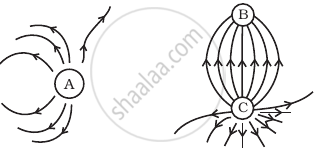Advertisements
Advertisements
प्रश्न
The intensity of the electric field at a perpendicular distance of 0·5 m from an infinitely long line charge having linear charge density (λ) is 3-6 × 103 Vm-1. Find the value of λ.
उत्तर
λ =n E.2π∈0r where E =3.6 ×103 Vm-1, R= 5m
∴ λ = 3.6 × 103 ×05 ×2 ×3.14 × 8.85 ×10-12
= 3.6 × 103 ×3.14 ×8.85 ×10-12
= 100× 10-9
=10-7 Cm-1
∴ λ = 10-7 Cm-1
APPEARS IN
संबंधित प्रश्न
Why do the electrostatic field lines not form closed loops?
Why do the electric field lines never cross each other?
- An electrostatic field line is a continuous curve. That is, a field line cannot have sudden breaks. Why not?
- Explain why two field lines never cross each other at any point?
A point charge (+Q) is kept in the vicinity of an uncharged conducting plate. Sketch the electric field lines between the charge and the plate?
Two bar magnets are quickly moved towards a metallic loop connected across a capacitor ‘C’ as shown in the figure. Predict the polarity of the capacitor.

Answer the following question.
Draw the pattern of electric field lines when a point charge +q is kept near an uncharged conducting plate.
Explain why two field lines never cross each other at any point?
Which of the following figures represent the electric field lines due to a single negative charge?
If Ea be the electric field strength of a short dipole at a point on its axial line and Ee that on the equatorial line at the same distance, then:
Figure shows the electric field lines around three point charges A, B and C.

- Which charges are positive?
- Which charge has the largest magnitude? Why?
- In which region or regions of the picture could the electric field be zero? Justify your answer.
(i) near A, (ii) near B, (iii) near C, (iv) nowhere.
